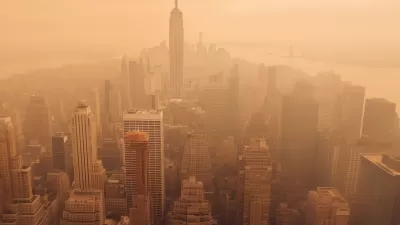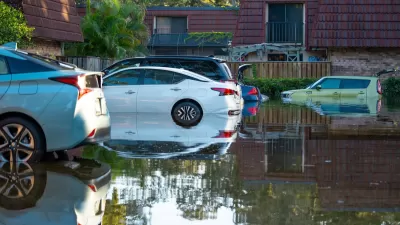Home insurers argue they should be able to base policy costs on modeling that accounts for future risks from climate change and overdevelopment.

The home insurance industry is calling on California to discourage construction in fire-prone zones by allowing insurers to account for future risks when evaluating policy applications. With climate change causing more extreme wildfire seasons and development pushing farther into high-risk areas, reports Debra Kahn, California insurers anticipate increasingly severe damage from wildfires. Meanwhile, homeowners in fire zones are finding it more difficult to secure policies or seeing their rates rise dramatically, even through the state's last-resort option, the FAIR plan. In October, the state temporarily banned insurers from dropping homeowners in areas affected by recent major wildfires.
Consumer watchdog groups warn that the proposed model, dubbed "catastrophic modeling" and used in every state except California, would defy consumer protection laws, and the state's insurance commissioner, Ricardo Lara, has shown reluctance to change the policy, opting to focus on a "consumer-oriented" approach that protects homeowners from exorbitant rate hikes. State politicians are similarly hesitant to dictate where development can happen, citing concerns that restrictions on construction could worsen the state's housing shortage.
But some experts warn that increased reliance on the FAIR program for the highest-risk homeowners could put an undue burden on taxpayers, much like FEMA's beleaguered flood insurance program. In Florida, which experiences frequent hurricanes and flooding, regulations on the insurance industry tie insurance to "more-stringent building codes, with incentives for going beyond the standards to install the sturdiest doors and windows" to reduce risks.
FULL STORY: California continues to face wildfire risks. Insurers think they have an answer.

Alabama: Trump Terminates Settlements for Black Communities Harmed By Raw Sewage
Trump deemed the landmark civil rights agreement “illegal DEI and environmental justice policy.”

Planetizen Federal Action Tracker
A weekly monitor of how Trump’s orders and actions are impacting planners and planning in America.

The 120 Year Old Tiny Home Villages That Sheltered San Francisco’s Earthquake Refugees
More than a century ago, San Francisco mobilized to house thousands of residents displaced by the 1906 earthquake. Could their strategy offer a model for the present?

Ken Jennings Launches Transit Web Series
The Jeopardy champ wants you to ride public transit.

BLM To Rescind Public Lands Rule
The change will downgrade conservation, once again putting federal land at risk for mining and other extractive uses.

Indy Neighborhood Group Builds Temporary Multi-Use Path
Community members, aided in part by funding from the city, repurposed a vehicle lane to create a protected bike and pedestrian path for the summer season.
Urban Design for Planners 1: Software Tools
This six-course series explores essential urban design concepts using open source software and equips planners with the tools they need to participate fully in the urban design process.
Planning for Universal Design
Learn the tools for implementing Universal Design in planning regulations.
Clanton & Associates, Inc.
Jessamine County Fiscal Court
Institute for Housing and Urban Development Studies (IHS)
City of Grandview
Harvard GSD Executive Education
Toledo-Lucas County Plan Commissions
Salt Lake City
NYU Wagner Graduate School of Public Service





























